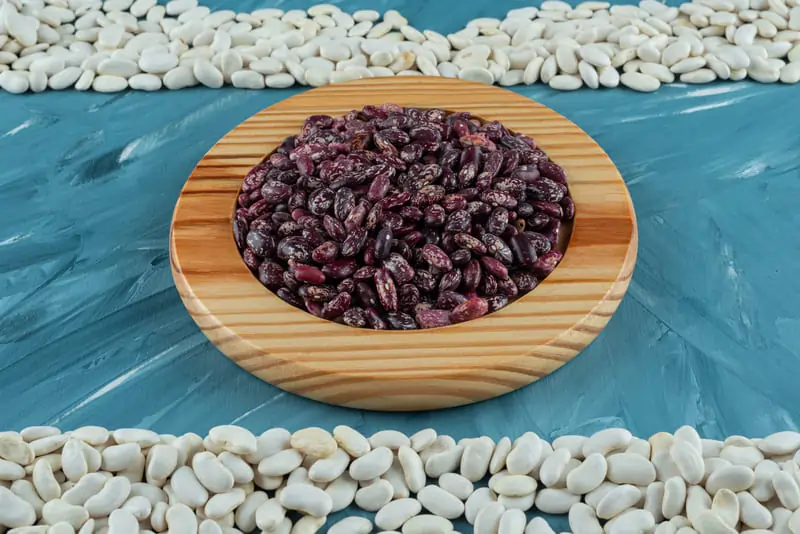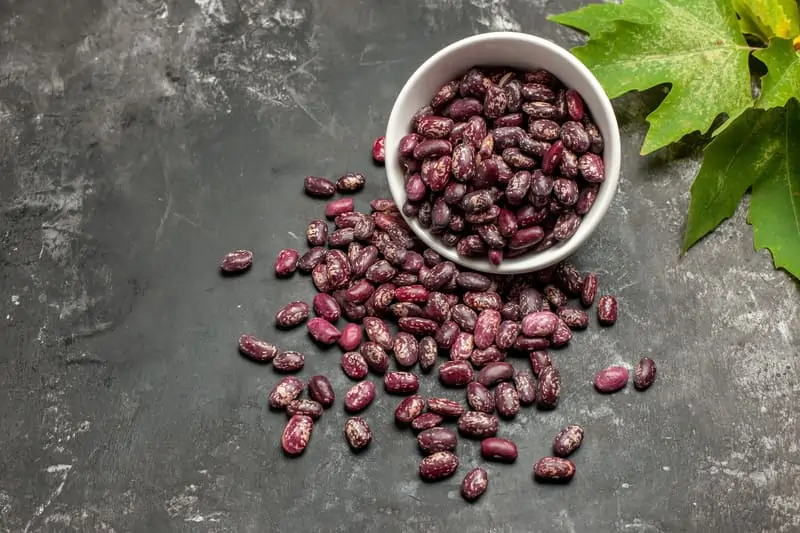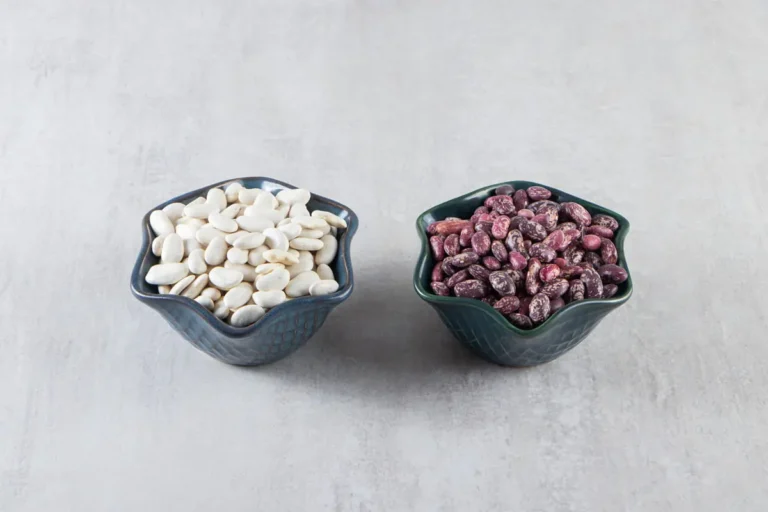It’s a common question—and for good reason. Beans are a staple in kitchens around the world, valued for their versatility, nutritional benefits, and cost-effectiveness. Among the many types available, white beans and navy beans are frequently confused due to their similar appearance. However, there are key differences in their size, texture, flavor, and how they’re used in recipes. This guide explores those differences, helping you choose the right bean for your culinary needs with confidence.
Understanding White Beans and Navy Beans: A Closer Look
What Are White Beans?
The term white beans encompasses several varieties, including great northern beans, cannellini beans, and navy beans. These beans share a creamy hue but differ significantly in size and texture.
For an exciting way to incorporate white beans into your meals, Read the Ultimate Guide to Vegan White Bean Chili for a plant-based take on a classic dish.
What Are Navy Beans?

Navy beans, also called Boston beans, are small, oval-shaped legumes with a creamy texture and mild flavor. These versatile beans are popular in many cuisines and are particularly valued for their ability to absorb flavors, making them a perfect base for various dishes.
Culinary Uses
- Traditional Dishes: Navy beans are a classic ingredient in baked beans, giving the dish its signature creamy texture. They are also frequently used in hearty soups and stews, such as navy bean soup with ham or vegetarian bean chili, where they add a satisfying bite.
- Versatile Additions: Beyond traditional recipes, navy beans can be pureed to create creamy dips or spreads or included in salads for added protein and fiber. For ideas on using beans creatively, explore our guide on unique bean-based recipes.
Nutritional Benefits
- Protein Powerhouse: Navy beans are a rich source of plant-based protein, making them an excellent choice for vegetarians and vegans.
- High in Fiber: Their high fiber content supports digestion and helps maintain a healthy gut. Fiber also contributes to satiety, making navy beans a great option for weight management.
- Packed with Micronutrients: Navy beans are loaded with essential vitamins and minerals, including folate, magnesium, and iron, which support energy production and overall health.
Cooking Tips
- Preparation: To enjoy navy beans at their best, soak them overnight if using dried beans. This reduces cooking time and improves their digestibility. Canned navy beans are a convenient alternative that can be rinsed and added directly to recipes.
- Flavor Pairings: Navy beans pair well with herbs like rosemary and thyme, smoky flavors from bacon or smoked paprika, and acidic ingredients like tomatoes or vinegar.
For additional culinary inspiration and ideas on incorporating navy beans, Understand the Difference Between White Chili and Regular Chili. Understanding the versatility of navy beans can help you create hearty, nutritious meals that satisfy your taste buds.
Taste and Texture: A Comparison
Navy beans and great northern beans offer unique taste and texture profiles that suit different culinary purposes. Understanding their individual characteristics can help you select the best bean for your recipe.
Navy Beans: Mild and Creamy
- Flavor Profile:
Navy beans have a subtle, mild flavor that complements a variety of seasonings and ingredients. Their neutrality allows them to absorb surrounding flavors, making them a versatile addition to soups, stews, and creamy dishes. - Creamy Texture:
These beans break down easily during cooking, resulting in a soft and creamy consistency. This texture is perfect for blending into smooth soups, like navy bean soup, or thickening broths without the need for added thickeners. For more ideas, explore our guide on creamy bean-based recipes.
Great Northern Beans: Nutty and Firm
- Flavor Profile:
Great northern beans have a slightly nutty flavor that stands out more than navy beans. This subtle nuttiness enhances the taste of dishes where beans play a central role, such as salads or dips. - Firmer Texture:
Unlike navy beans, great northern beans hold their shape during cooking. Their firmer texture adds a satisfying bite, making them ideal for recipes like white bean chili, hearty casseroles, or cold bean salads.
Choosing the Right Bean for Your Recipe
- When to Use Navy Beans:
If you’re making creamy soups, dips, or baked beans, navy beans are the perfect choice due to their ability to blend smoothly into the dish. Their mild flavor won’t overpower the other ingredients, allowing seasonings and complementary flavors to shine. - When to Use Great Northern Beans:
For recipes requiring beans to maintain their structure, such as in stews, casseroles, or dips, great northern beans are the better option. Their nutty flavor adds depth, while their firmness enhances the dish’s texture. For a hearty recipe using great northern beans, try our white bean casserole.
Nutritional Differences Between Navy Beans and Great Northern Beans

Both navy beans and great northern beans offer impressive health benefits, making them excellent additions to a balanced diet. However, their slight nutritional differences can help determine which bean is better suited to your specific dietary needs or health goals.
Navy Beans: Protein-Packed and Rich in Iron
- High Protein Content:
Navy beans are an excellent source of plant-based protein, making them ideal for vegetarians, vegans, and anyone seeking muscle growth and repair. A serving of navy beans provides about 15 grams of protein, offering a robust contribution to daily protein requirements. - Rich in Dietary Fiber:
These beans are also high in fiber, which supports healthy digestion, stabilizes blood sugar levels, and promotes a feeling of fullness. Incorporating navy beans into soups or stews is a great way to boost fiber intake. - Iron for Energy and Vitality:
Navy beans are a good source of iron, an essential mineral that supports oxygen transport and energy production. For individuals with iron deficiencies, such as those following plant-based diets, navy beans can be a valuable dietary addition.
Great Northern Beans: Calcium-Rich and Lower in Calories
- Calcium for Bone Health:
Great northern beans are slightly higher in calcium compared to navy beans. This makes them an excellent choice for supporting bone strength and overall skeletal health. Pairing these beans with vitamin D-rich foods can enhance calcium absorption. - Lower Caloric Content:
With fewer calories per serving than navy beans, great northern beans are a suitable option for those focusing on weight management. Their firm texture and nutty flavor make them a satisfying low-calorie choice in salads, dips, and soups. Discover more ideas in our guide on healthy bean-based recipes.
Which Bean Should You Choose?
- For Muscle Growth and Iron Needs:
If you’re aiming to increase protein intake or combat iron deficiency, navy beans are the better choice. They work well in creamy dishes, like navy bean soup or baked beans, where their soft texture enhances the dish. - For Bone Health and Weight Management:
Great northern beans are ideal for individuals seeking calcium-rich, low-calorie foods. Their firmer texture and nutty taste make them a perfect addition to recipes like white bean chili or hearty salads. For more substitutions and alternatives, read our article on good substitutes for white beans in chili.
Culinary Applications of White Beans and Navy Beans
Both navy beans and great northern beans are versatile ingredients that enhance a variety of dishes. Their unique textures and flavors make them ideal for different culinary applications, ensuring you can use each to its fullest potential.
Best Uses for Navy Beans
- Soups and Stews:
Navy beans excel in soups and stews due to their creamy texture, which naturally thickens broths as they cook. They absorb seasonings beautifully, adding richness to recipes like navy bean soup or hearty vegetable stews. For ideas on incorporating them into your meals, check out our guide on bean-based soups and stews. - Baked Beans:
Their mild flavor makes navy beans a staple in classic baked bean recipes. The beans soak up sweet and tangy sauces, creating a delicious side dish that pairs perfectly with barbecue or roasted vegetables. - Purees and Dips:
Navy beans blend smoothly into creamy purees and dips. Their neutral taste allows them to be seasoned with herbs, spices, or garlic for spreads like white bean hummus. They’re also a great base for vegan cheese sauces or creamy pasta dishes.
Best Uses for Great Northern Beans
- Salads:
Great northern beans retain their shape and texture, making them ideal for cold bean salads. Their nutty flavor complements fresh ingredients like tomatoes, cucumbers, and herbs, creating a light and satisfying dish. For inspiration. - Casseroles:
Their firm texture adds substance to baked dishes like casseroles. Great northern beans hold up well in the oven, adding protein and bulk to recipes like white bean and spinach gratin or vegetarian shepherd’s pie. - Dips and Spreads:
The slightly nutty flavor of great northern beans pairs well with creamy bases, making them a great choice for dips like hummus or bean-based spreads. Their texture adds body to recipes, ensuring a rich and satisfying result.
Explore White Beans’ Versatility
For a creative take on using great northern beans, try incorporating them into unique recipes like Great Northern Bean Pizza. The beans add an unexpected twist, providing a hearty and protein-packed topping that pairs well with flavorful sauces and cheeses. Discover more in our article on innovative ways to cook with beans.
How to Choose the Right Bean for Your Recipe
Selecting the appropriate bean can significantly impact the texture, flavor, and overall outcome of your dish. Here’s a guide to help you decide whether navy beans or great northern beans are the best fit for your recipe.
Creamy Texture: Navy Beans
- Soups and Stews:
Navy beans are perfect for dishes that require a smooth and creamy consistency. As they cook, they break down easily, naturally thickening broths and creating a velvety texture. This makes them ideal for recipes like navy bean soup or creamy vegetable stews. - Purees and Dips:
Their soft texture also makes navy beans an excellent choice for purees, dips, and spreads. Whether you’re blending them into a white bean hummus or creating a creamy vegan sauce, navy beans provide a smooth base that absorbs seasonings beautifully.
For a Firm Bite: Great Northern Beans
- Salads:
Great northern beans retain their shape and provide a satisfying bite, making them perfect for cold bean salads. Their slightly nutty flavor pairs well with fresh ingredients like tomatoes, cucumbers, and herbs, creating a hearty yet refreshing dish. - Casseroles:
Their firmer texture also works well in baked dishes, such as casseroles or gratins. Great northern beans hold up during cooking, adding substance and protein to recipes like white bean and kale casserole or baked pasta dishes.
For Mild Flavor: Both Beans Work
- Subtlety in Dishes:
Both navy beans and great northern beans have mild flavors, but navy beans are slightly subtler. If you want the beans to take a backseat to other bold ingredients, navy beans are an excellent choice. For dishes where a nuttier, more pronounced bean flavor complements the recipe, great northern beans are the way to go.
FAQs
Are all white beans the same?
No, white beans include several varieties, such as cannellini beans, great northern beans, and navy beans, each with distinct qualities. To learn more about these varieties and how they are used in recipes, Read the Ultimate Guide to Vegan White Bean Chili.
Can navy beans be substituted for other white beans?
Yes, but their smaller size and softer texture may slightly alter the dish’s consistency. For tips on swapping ingredients effectively, Discover Good Substitutes for White Beans in Chili.
Which type of white bean is healthiest?
Both beans are nutritious, but navy beans are higher in protein and iron, while great northern beans provide more calcium and potassium. If you’re looking for other nutrient-dense options, explore the differences between chili varieties in Understand the Difference Between White Chili and Regular Chili.
Do navy beans take longer to cook?
No, navy beans often cook faster due to their smaller size. For a deeper dive into cooking tips for legumes, including lentils, visit Lentil Soup Nutrition: A Comprehensive Guide.
Conclusion:
Recognizing the distinctions between white beans and navy beans can enhance both your cooking and ingredient choices. Navy beans, with their soft and creamy texture, are ideal for soups, stews, and baked dishes. In contrast, great northern beans offer a firmer bite, making them perfect for salads, casseroles, and recipes where texture matters.
For further inspiration, explore related recipes like Read the Ultimate Guide to Vegan White Bean Chili and Understand the Difference Between White Chili and Regular Chili.

